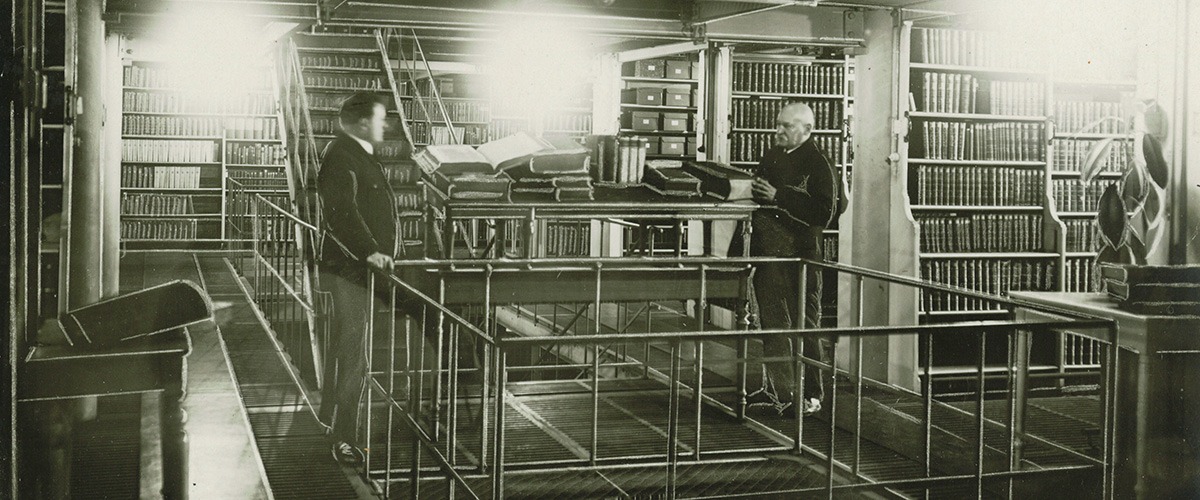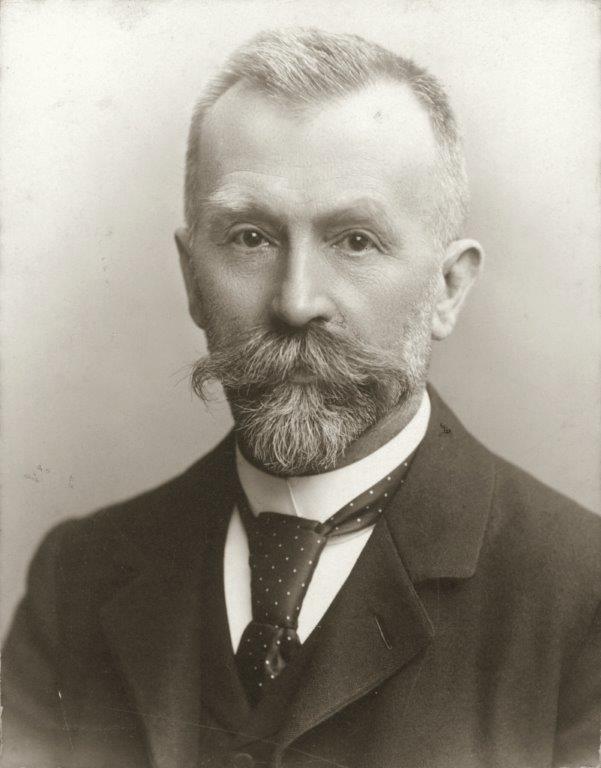Imperial Court of Justice library
The Imperial Court of Justice absorbed the library inventory owned by the former Reichsoberhandelsgericht when it was founded in 1879. This amounted to approximately 20,000 volumes.

The Imperial Court of Justice absorbed the library inventory owned by the former Reichsoberhandelsgericht when it was founded in 1879. This amounted to approximately 20,000 volumes.
The library at the Imperial Court of Justice developed into Germany's largest and most important law library under the committed leadership of its first director, Karl Schulz. All of the contemporary reference literature was purchased. Moreover, Karl Schulz acquired large collections of antiquarian literature, some of it on his numerous trips to Italy. Among them were 500 municipal charters from Upper Italy; no other library outside of Italy has such a valuable collection of statutes from Italian cities. The legal literature published after 1800 was owned almost completely. A larger and representative selection of titles released before 1800 was also present, including manuscripts and 238 incunabula.

Born 1844 in Salzungen, Karl Schulz read law in Heidelberg, Berlin and Jena. He completed his articles and dissertation in 1867 and went on to work for a number of courts in Thuringia. Sitting his second state examination in 1872, he earned his post-doctoral qualifications with a thesis on the Survey of Saxon Law, known as the Sachsenspiegel. He went on to lecture on the history of German imperial law, German civil law, exchange law and the Survey of Saxon Law. Karl Schulz accepted the position as inaugural director of the Imperial Court of Justice library on 1 October 1879 after receiving instruction in library management at the University of Jena. He held the office for 38 years. Besides library management and law, he was also a passionate Alpinist. He took part in the first unguided ascent and descent of opposing sides of the Matterhorn and the first ascent of the Bietschorn's southern face, publishing his experience, observations and descriptions of the tours in Alpine journals. Aged 73, Karl Schulz retired on 1 April 1917. He moved to Munich, where he passed away in 1929.
The library of the Imperial Court of Justice owned 170,000 works at the outbreak of the First World War. It was forced to introduce rigorous austerity policies during and after the First World War. The acquisition of non-legal literature was severely restricted. This period also featured the first sales of inventory that was considered superfluous. Members of the Imperial Court of Justice were expected to donate their own scholarly publications and review copies to the library free of charge. Publishers extended discounts.
The city of Leipzig was repeatedly pummelled by heavy aerial bombardment during the Second World War. The library director Paul Güntzel responded to the first attacks by moving large sections of the library to the vaults beneath the Imperial Court of Justice, the basement of the Monument to the Battle of the Nations and a mine in Anhalt. The fourstorey library storeroom in the northern wing of the building was rendered useless by an aerial attack on 6 April 1945, and the catalogue room was destroyed by fire. Around 20,000 of the library's total inventory of around 300,000 works were destroyed.
The Imperial Court of Justice library was placed in the charge of the President of the Leipzig Regional Court under the administration of the State of Saxony in October 1945. In the years following the War, the inventory was used by professors and students at the Leipzig University Faculty of Law, in addition to judges, lawyers and professional jurists. It was expanded again with the aim of returning it to one of Germany's highest courts.
In autumn 1950, the library was moved from Leipzig to the building of the Supreme Court of the GDR in Berlin. In the following years it eked out a marginal existence, as the Supreme Court did not require legal literature from before 1945. There was no space for the Imperial Court of Justice library when the Court moved to new premises in 1974, apart from just 10,000 volumes. Large parts of the non-legal works were donated to the German National Library, while others were destroyed or sold to raise hard currency. The sections of the library deemed worthy of preservation were placed in storage in the state reserves in Oranienburg. A total of 100,000 volumes were returned to Berlin two years later and kept in a factory building, while the more valuable sections were taken to state reserves in Forst.
After accession of the GDR to the Federal Republic of Germany, the Ministry of Justice instructed the Federal Court of Justice to absorb the library of the former Supreme Court of the GDR as its functional successor. Imperilled by decay, many of the books were removed from the state reserves and taken to Karlsruhe, where they were inspected, given initial care and partially catalogued. Preparations were also made for extensive restoration in future.
The future home of the former Imperial Court of Justice library became an issue once it was clear in spring 1992 that the Federal Court of Justice would not move its seat from Karlsruhe to Leipzig, and that instead the Federal Administrative Court would relocate there from Berlin. Experts from the world of legal history also contributed to the debate. Some of them were keen to move the former Imperial Court of Justice library back to its home in the original building. Others considered it a historical, complementary inventory belonging to the Federal Court of Justice library, which had been built after the end of the War. Ultimately the various parties agreed on a compromise: The library of the Supreme Court of the GDR – as well as the Imperial Court of Justice library it contained – was shared.
Historically valuable parts of the inventory (approx. 10,000 works in the sections A–X, published before 1800) were moved to Leipzig. They encompass European legal history from the works of the 12th century legal scholars of Bologna. General works (including decisions and legal dictionaries) and publications on Roman law (including annotated editions of the Corpus Iuris Civilis), on canon law (including annotated editions of the Decretum Gratiani) and Italian municipal charters account for the lion's share of the inventory. The collection of various editions of the Survey of Saxon Law (Sachsenspiegel) and the Survey of Swabian Law (Schwabenspiegel) is remarkable.
Moreover, the Federal Administrative Court also received a part of the works owned by the Imperial Court of Justice that were published in the period 1800 to 1945. This consists of around 54,000 editions in section A (Miscellaneous), G (State Law), H (Canon Law), J (International Law, not including Privat International Law), K (Particular Law: Residual inventory of works from the historical states in the territory of the GDR), L (Austria), M (Switzerland), TA-TD (Russia etc.), U (Non-European Countries) and Gesch (History).
Forty-three medieval manuscripts from the Imperial Court of Justice library were catalogued and digitised in the Manuscripts Centre of the Leipzig University Library. The work was conducted as part of a project to improve the accessibility of medieval manuscripts in Saxony and Greater Leipzig. The project was funded by the German research Foundation (Deutsche Forschungsgemeinschaft). You can view the digital manuscripts from the Imperial Court of Justice library on the website of Manuscripta Mediaevalia.
In 2005, Professor Gero Rudolf Dolezalek had already viewed all the manuscripts available in the Federal Administrative Court and prepared brief descriptions of their contents.